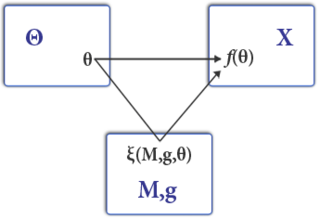Game theory is the study of mathematical models of strategic interactions among rational agents. It has applications in many fields of social science, used extensively in economics as well as in logic, systems science and computer science. Traditional game theory addressed two-person zero-sum games, in which a participant's gains or losses are exactly balanced by the losses and gains of the other participant. In the 21st century, game theory applies to a wider range of behavioral relations, and it is now an umbrella term for the science of logical decision making in humans, animals, as well as computers.

Theoretical computer science (TCS) is a subset of general computer science and mathematics that focuses on mathematical aspects of computer science such as the theory of computation, formal language theory, the lambda calculus and type theory.
In quantum computing, a quantum algorithm is an algorithm which runs on a realistic model of quantum computation, the most commonly used model being the quantum circuit model of computation. A classical algorithm is a finite sequence of instructions, or a step-by-step procedure for solving a problem, where each step or instruction can be performed on a classical computer. Similarly, a quantum algorithm is a step-by-step procedure, where each of the steps can be performed on a quantum computer. Although all classical algorithms can also be performed on a quantum computer, the term quantum algorithm is usually used for those algorithms which seem inherently quantum, or use some essential feature of quantum computation such as quantum superposition or quantum entanglement.
In mathematics, economics, and computer science, the stable marriage problem is the problem of finding a stable matching between two equally sized sets of elements given an ordering of preferences for each element. A matching is a bijection from the elements of one set to the elements of the other set. A matching is not stable if:

Mechanism design is a field in economics and game theory that takes an objectives-first approach to designing economic mechanisms or incentives, toward desired objectives, in strategic settings, where players act rationally. Because it starts at the end of the game, then goes backwards, it is also called reverse game theory. It has broad applications, from economics and politics in fields such as market design, auction theory and social choice theory to networked-systems.
In theoretical computer science and cryptography, a pseudorandom generator (PRG) for a class of statistical tests is a deterministic procedure that maps a random seed to a longer pseudorandom string such that no statistical test in the class can distinguish between the output of the generator and the uniform distribution. The random seed itself is typically a short binary string drawn from the uniform distribution.
A mechanism is called incentive-compatible (IC) if every participant can achieve the best outcome to themselves just by acting according to their true preferences. For example, there is incentive compatibility if high-risk clients are better off in identifying themselves as high-risk to insurance firms, who only sell discounted insurance to high-risk clients. Likewise, they would be worse off if they pretend to be low-risk. Low-risk clients who pretend to be high-risk would also be worse off.

A combinatorial auction is a type of smart market in which participants can place bids on combinations of discrete heterogeneous items, or “packages”, rather than individual items or continuous quantities. These packages can be also called lots and the whole auction a multi-lot auction. Combinatorial auctions are applicable when bidders have non-additive valuations on bundles of items, that is, they value combinations of items more or less than the sum of the valuations of individual elements of the combination.
Agent-based computational economics (ACE) is the area of computational economics that studies economic processes, including whole economies, as dynamic systems of interacting agents. As such, it falls in the paradigm of complex adaptive systems. In corresponding agent-based models, the "agents" are "computational objects modeled as interacting according to rules" over space and time, not real people. The rules are formulated to model behavior and social interactions based on incentives and information. Such rules could also be the result of optimization, realized through use of AI methods.
Algorithmic game theory (AGT) is an area in the intersection of game theory and computer science, with the objective of understanding and design of algorithms in strategic environments.
Distributed algorithmic mechanism design (DAMD) is an extension of algorithmic mechanism design.
Universal Darwinism, also known as generalized Darwinism, universal selection theory, or Darwinian metaphysics, is a variety of approaches that extend the theory of Darwinism beyond its original domain of biological evolution on Earth. Universal Darwinism aims to formulate a generalized version of the mechanisms of variation, selection and heredity proposed by Charles Darwin, so that they can apply to explain evolution in a wide variety of other domains, including psychology, linguistics, economics, culture, medicine, computer science, and physics.

Noam Nisan is an Israeli computer scientist, a professor of computer science at the Hebrew University of Jerusalem. He is known for his research in computational complexity theory and algorithmic game theory.
In mechanism design, a Vickrey–Clarke–Groves (VCG) mechanism is a generic truthful mechanism for achieving a socially-optimal solution. It is a generalization of a Vickrey–Clarke–Groves auction. A VCG auction performs a specific task: dividing items among people. A VCG mechanism is more general: it can be used to select any outcome out of a set of possible outcomes.
Truthful job scheduling is a mechanism design variant of the job shop scheduling problem from operations research.
A Bayesian-optimal mechanism (BOM) is a mechanism in which the designer does not know the valuations of the agents for whom the mechanism is designed, but the designer knows that they are random variables and knows the probability distribution of these variables.
Fisher market is an economic model attributed to Irving Fisher. It has the following ingredients:

A deferred-acceptance auction (DAA) is an auction in which the allocation is chosen by repeatedly rejecting the least attractive bids. It is a truthful mechanism with strategic properties that make it particularly suitable to complex auctions such as the radio spectrum reallocation auction. An important advantage of DAA over the more famous VCG auction is that DAA is immune to manipulations by coalitions of bidders, while VCG is immune to manipulations only by individual bidders.
Michal Feldman is a full professor of Computer Science and the Chair of Computation and Economics at Tel Aviv University, the head of Economics and Computation (EC) lab, and a visiting researcher in Microsoft Research Israel. Michal’s research focuses on algorithmic game theory, an area that lies in the intersection of computer science, microeconomics and game theory. Among other topics, she studies auction theory, mechanism design, algorithm design, the price of anarchy, and e-commerce. Michal is an alumna of the Israel Young Academy and of the Global Young Academy. Her research is funded by prestigious grants, including, among others, grants of the ERC : ERC starters and ERC consolidator, ISF grants, and an Amazon Research Award. She was selected by the Forbes magazine as one of the most influencing women in Israel in 2016., and is the recipient of the Kadar Award, Bruno Award, and ACM SIGecom mid-career Award.

A knapsack auction is an auction in which several identical items are sold, and there are several bidders with different valuations interested in different amounts of items. The goal is to choose a subset of the bidders with a total demand, at most, the number of items and, subject to that, a maximum total value. Finding this set of bidders requires solving an instance of the knapsack problem, which explains the term "knapsack auction".